engine ACURA TL 1995 Service Owners Manual
[x] Cancel search | Manufacturer: ACURA, Model Year: 1995, Model line: TL, Model: ACURA TL 1995Pages: 1771, PDF Size: 62.49 MB
Page 275 of 1771
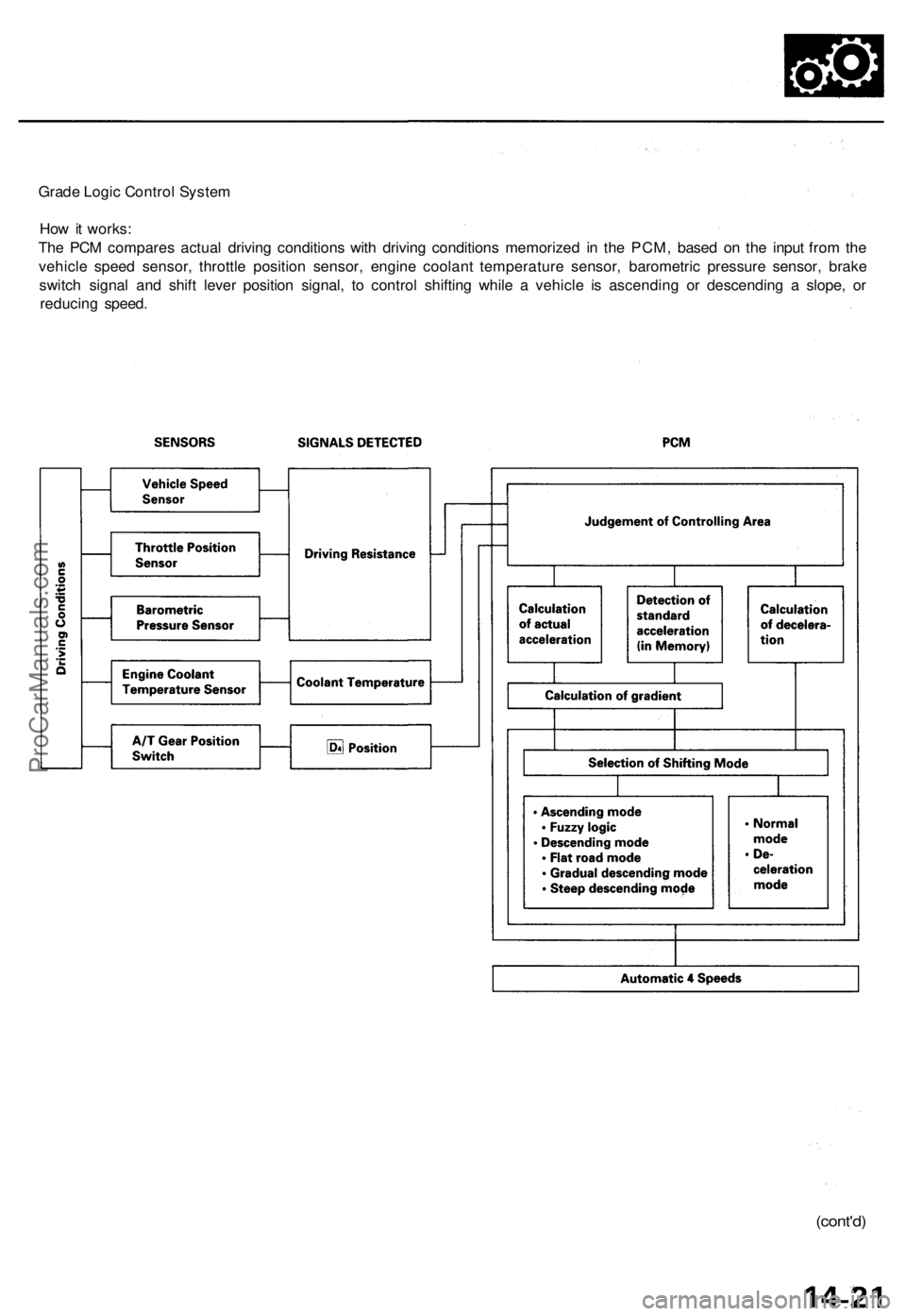
Grade Logic Control System
How it works:
The PCM compares actual driving conditions with driving conditions memorized in the PCM, based on the input from the
vehicle speed sensor, throttle position sensor, engine coolant temperature sensor, barometric pressure sensor, brake
switch signal and shift lever position signal, to control shifting while a vehicle is ascending or descending a slope, or
reducing speed.
(cont'd)ProCarManuals.com
Page 277 of 1771
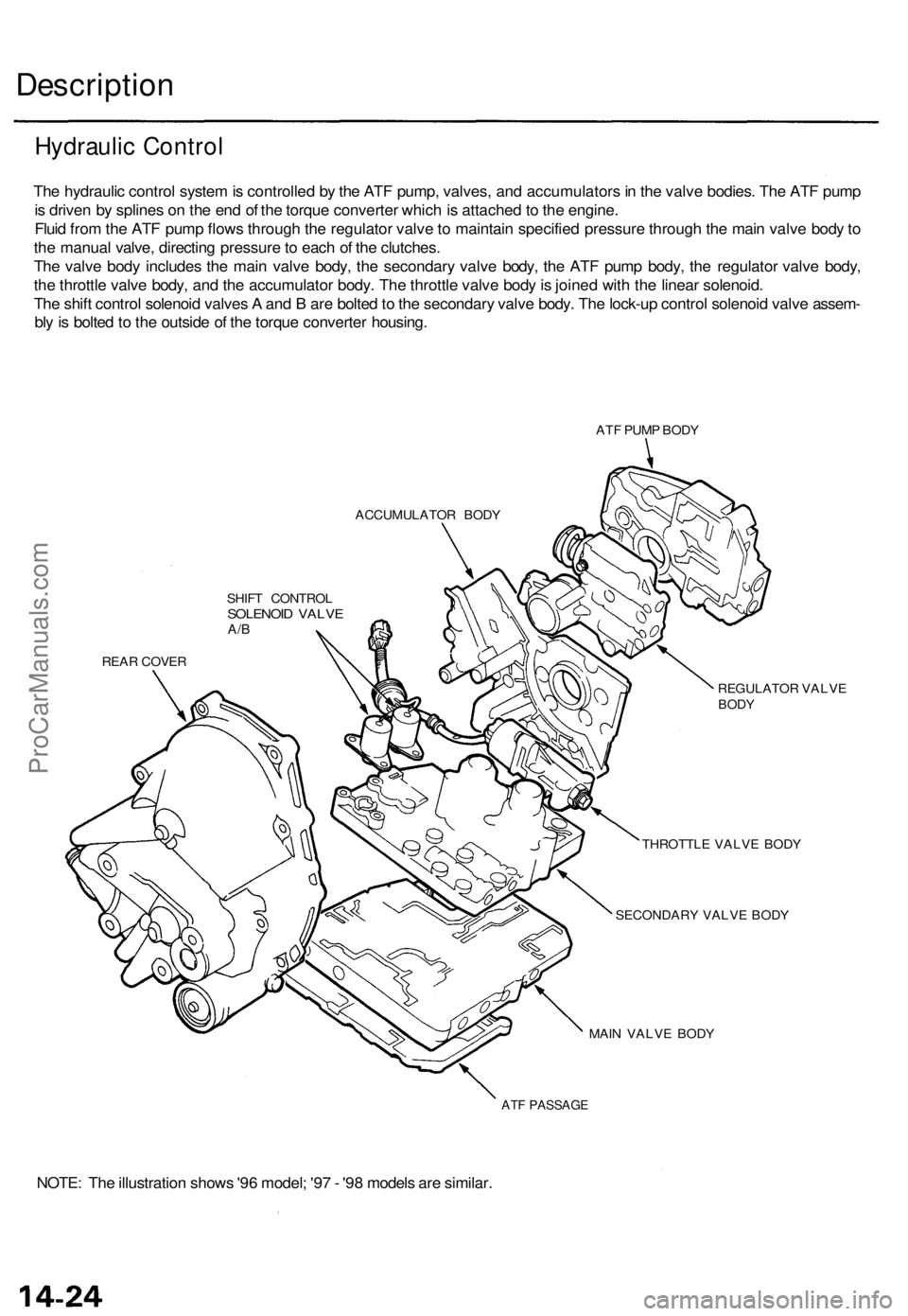
Description
The hydraulic control system is controlled by the ATF pump, valves, and accumulators in the valve bodies. The ATF pump
is driven by splines on the end of the torque converter which is attached to the engine.
Fluid from the ATF pump flows through the regulator valve to maintain specified pressure through the main valve body to
the manual valve, directing pressure to each of the clutches.
The valve body includes the main valve body, the secondary valve body, the ATF pump body, the regulator valve body,
the throttle valve body, and the accumulator body. The throttle valve body is joined with the linear solenoid.
The shift control solenoid valves A and B are bolted to the secondary valve body. The lock-up control solenoid valve assem-
bly is bolted to the outside of the torque converter housing.
ATF PUMP BODY
ACCUMULATOR BODY
SHIFT CONTROL
SOLENOID VALVE
A/B
REAR COVER
REGULATOR VALVE
BODY
THROTTLE VALVE BODY
SECONDARY VALVE BODY
MAIN VALVE BODY
ATF PASSAGE
NOTE: The illustration shows '96 model; '97 - '98 models are similar.
Hydraulic ControlProCarManuals.com
Page 281 of 1771
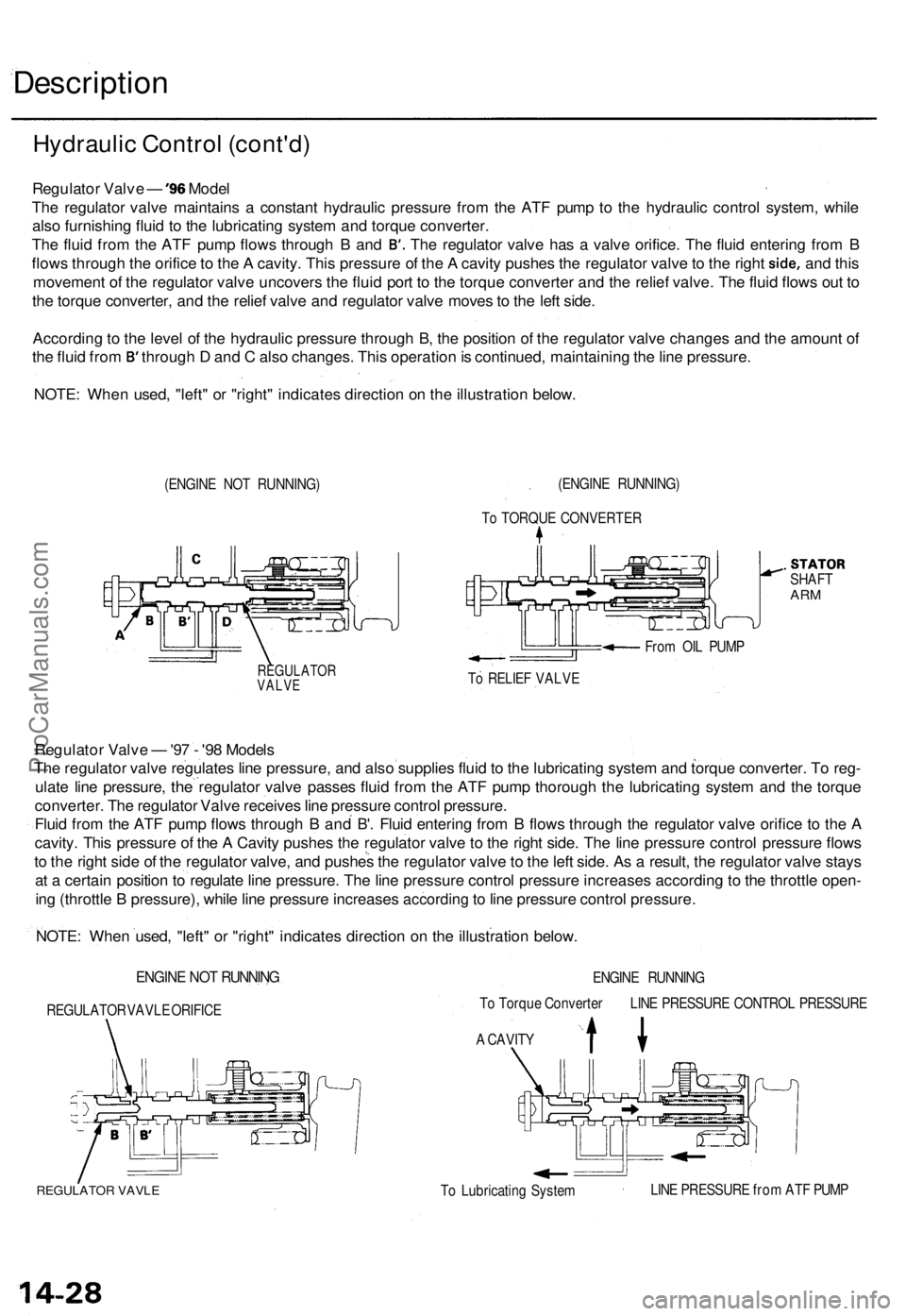
Description
Regulator Valv e — '9 6 Mode l
Th e regulato r valv e maintain s a constan t hydrauli c pressur e fro m th e AT F pum p t o th e hydrauli c contro l system , whil e
als o furnishin g flui d t o th e lubricatin g syste m an d torqu e converter .
The flui d fro m th e AT F pum p flow s throug h B an d B'. Th e regulato r valv e ha s a valv e orifice . Th e flui d enterin g fro m B
flow s throug h th e orific e to th e A cavity . Thi s pressur e o f th e A cavit y pushe s th e regulato r valv e to th e righ t side , and thi s
movemen t o f th e regulato r valv e uncover s th e flui d por t t o th e torqu e converte r an d th e relie f valve . Th e flui d flow s ou t t o
th e torqu e converter , an d th e relie f valv e an d regulato r valv e move s to th e lef t side .
Accordin g to th e leve l o f th e hydrauli c pressur e throug h B , th e positio n o f th e regulato r valv e change s an d th e amoun t o f
th e flui d fro m B' throug h D an d C als o changes . Thi s operatio n is continued , maintainin g th e lin e pressure .
NOTE : Whe n used , "left " o r "right " indicate s directio n o n th e illustratio n below .
(ENGIN E NO T RUNNING )
.STATORSHAFTARM
Fro m OI L PUM P
REGULATO RVALVETo RELIE F VALV E
Regulato r Valv e — '9 7 - '98 Model s
Th e regulato r valv e regulate s lin e pressure , an d als o supplie s flui d to th e lubricatin g syste m an d torqu e converter . T o reg -
ulat e lin e pressure ,
the regulato r valv e passe s flui d fro m th e AT F pum p thoroug h th e lubricatin g syste m an d th e torqu e
converter . Th e regulato r Valv e receive s lin e pressur e contro l pressure .
Flui d fro m th e AT F pum p flow s throug h B an d
B'. Flui d enterin g fro m B flow s throug h th e regulato r valv e orific e t o th e A
cavity . Thi s pressur e o f th e A Cavit y pushe s th e regulato r valv e t o th e righ t side . Th e lin e pressur e contro l pressur e flow s
t o th e righ t sid e o f th e regulato r valve , an d pushe s th e regulato r valv e to th e lef t side . A s a result , th e regulato r valv e stay s
a t a certai n positio n to regulat e lin e pressure . Th e lin e pressur e contro l pressur e increase s accordin g t o th e throttl e open -
in g (throttl e B pressure) , whil e lin e pressur e increase s
accordin g to lin e pressur e contro l pressure .
NOTE : Whe n used , "left " o r "right " indicate s directio n o n th e illustratio n below .
ENGINE NO T RUNNIN G
REGULATO R VAVL E ORIFIC E ENGIN
E RUNNIN G
T o Torqu e Converte r LIN E PRESSUR E CONTRO L PRESSUR E
A CAVIT Y
REGULATO R VAVL ETo Lubricatin g Syste m LIN
E PRESSUR E fro m AT F PUM P
Hydrauli c Contro l (cont'd )
(ENGINE RUNNING )
T o TORQU E CONVERTE R
ProCarManuals.com
Page 284 of 1771
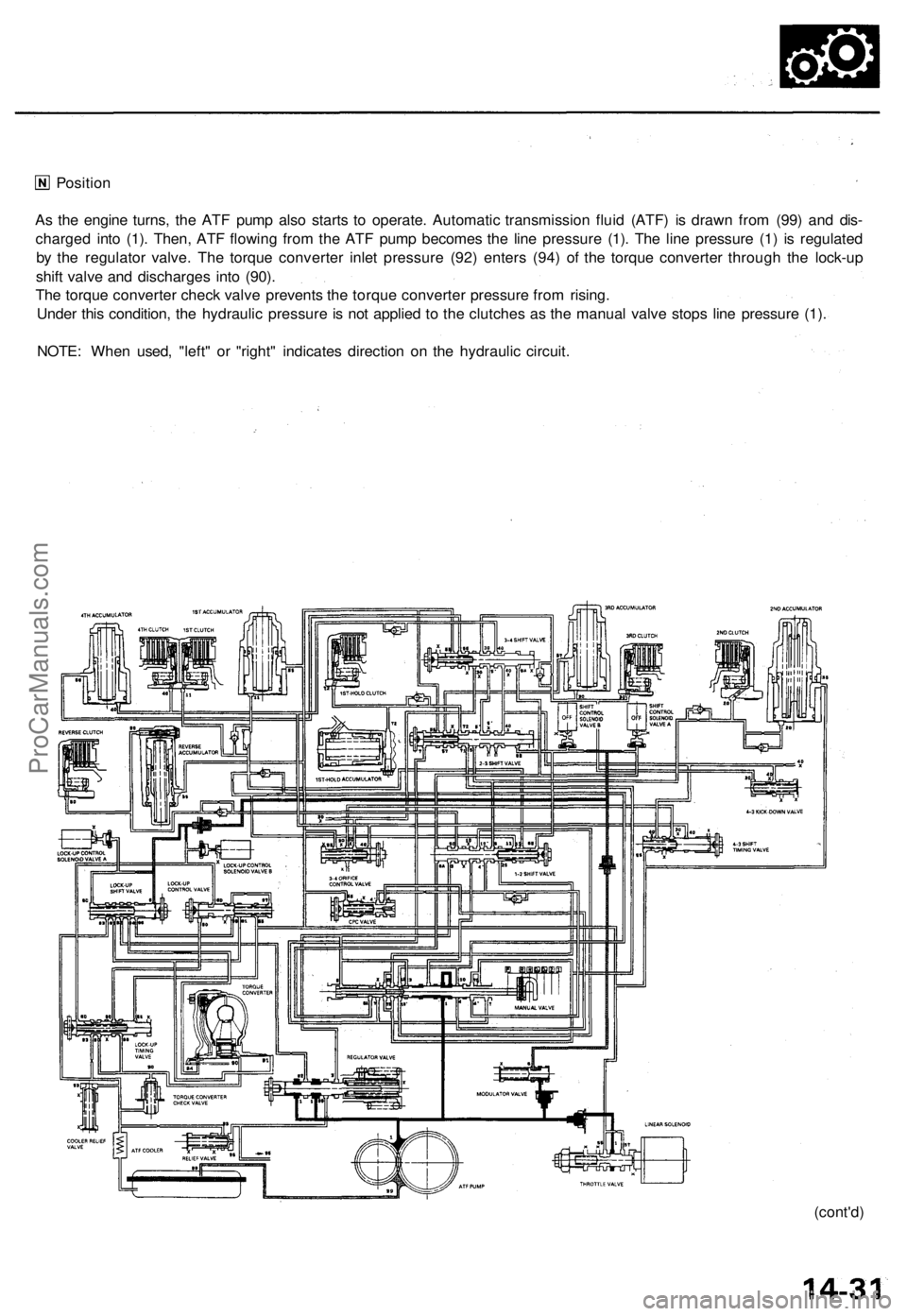
Position
(cont'd)
As the engine turns, the ATF pump also starts to operate. Automatic transmission fluid (ATF) is drawn from (99) and dis-
charged into (1). Then, ATF flowing from the ATF pump becomes the line pressure (1). The line pressure (1) is regulated
by the regulator valve. The torque converter inlet pressure (92) enters (94) of the torque converter through the lock-up
shift valve and discharges into (90).
The torque converter check valve prevents the torque converter pressure from rising.
Under this condition, the hydraulic pressure is not applied to the clutches as the manual valve stops line pressure (1).
NOTE: When used, "left" or "right" indicates direction on the hydraulic circuit.ProCarManuals.com
Page 287 of 1771
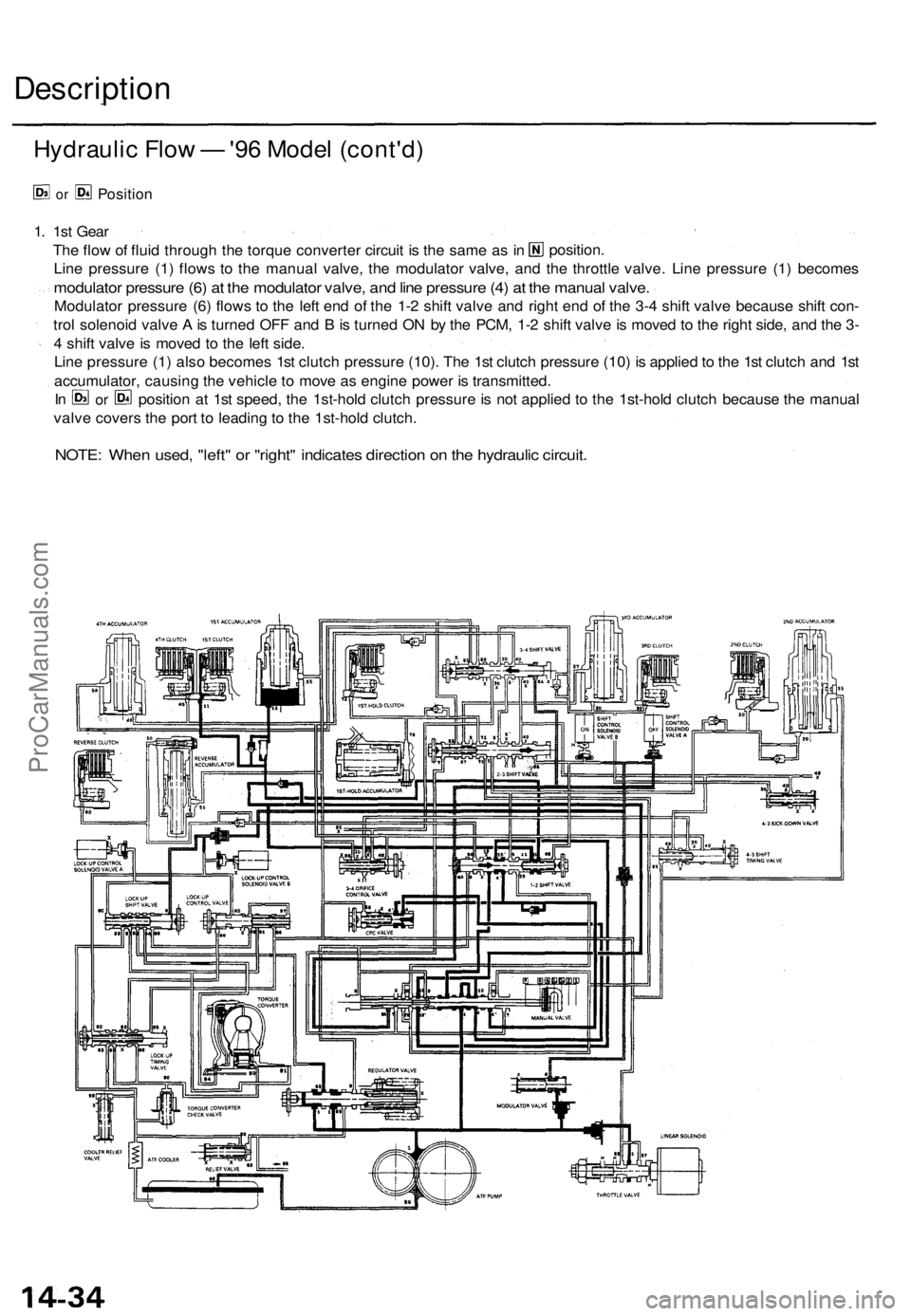
Description
Hydraulic Flow — '96 Model (cont'd)
or
Position
NOTE: When used, "left" or "right" indicates direction on the hydraulic circuit.
1. 1st Gear
Line pressure (1) flows to the manual valve, the modulator valve, and the throttle valve. Line pressure (1) becomes
modulator pressure (6) at the modulator valve, and line pressure (4) at the manual valve.
Modulator pressure (6) flows to the left end of the 1-2 shift valve and right end of the 3-4 shift valve because shift con-
trol solenoid valve A is turned OFF and B is turned ON by the PCM, 1-2 shift valve is moved to the right side, and the 3-
4 shift valve is moved to the left side.
Line pressure (1) also becomes 1st clutch pressure (10). The 1st clutch pressure (10) is applied to the 1st clutch and 1st
accumulator, causing the vehicle to move as engine power is transmitted.
valve covers the port to leading to the 1st-hold clutch.
position.
The flow of fluid through the torque converter circuit is the same as in
In
or
position at 1st speed, the 1st-hold clutch pressure is not applied to the 1st-hold clutch because the manualProCarManuals.com
Page 293 of 1771
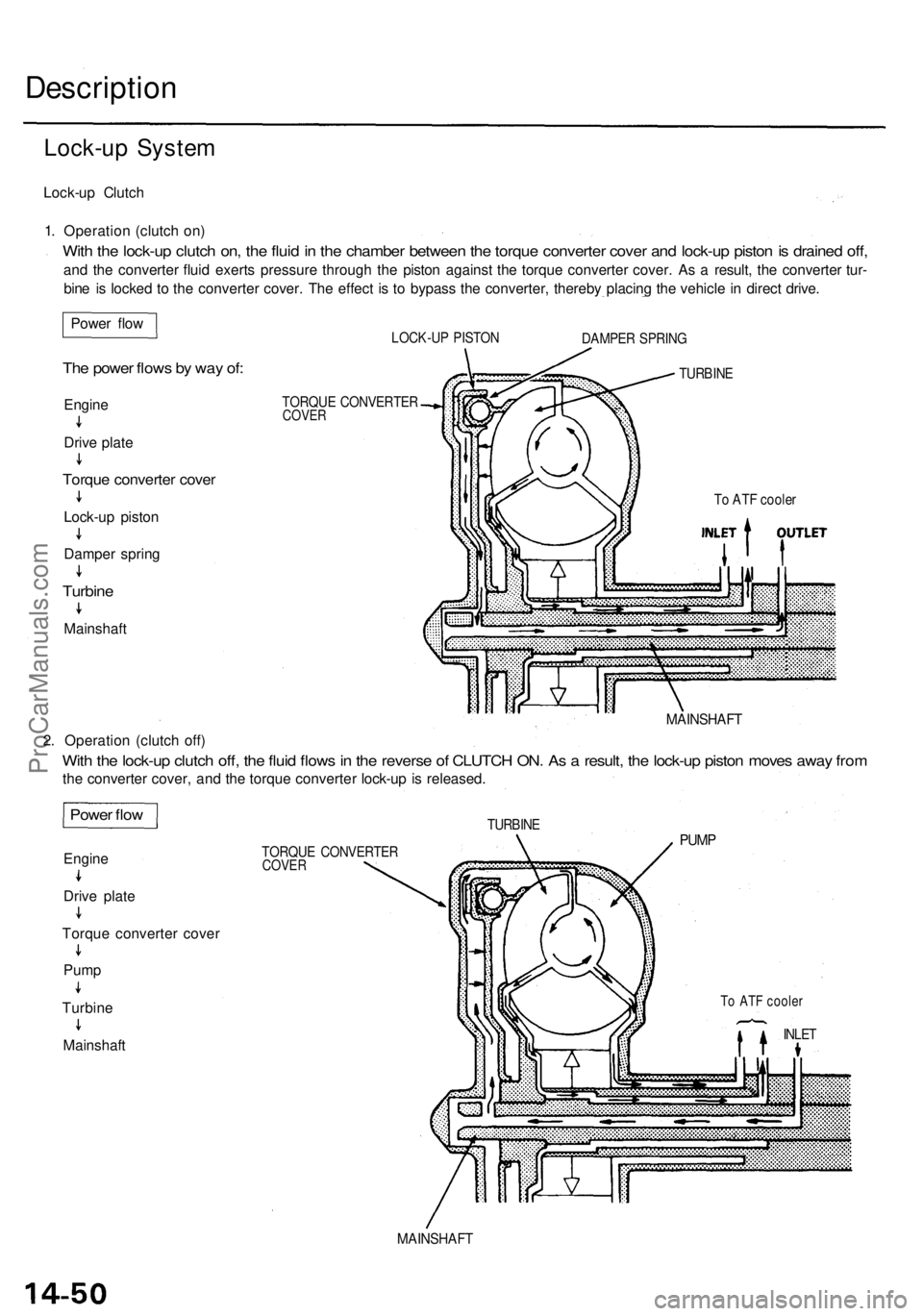
Description
Lock-up System
Lock-up Clutch
1. Operation (clutch on)
With the lock-up clutch on, the fluid in the chamber between the torque converter cover and lock-up piston is drained off,
and the converter fluid exerts pressure through the piston against the torque converter cover. As a result, the converter tur-
bine is locked to the converter cover. The effect is to bypass the converter, thereby placing the vehicle in direct drive.
LOCK-UP PISTON
TORQUE CONVERTER
COVER
TURBINE
DAMPER SPRING
To ATF cooler
TURBINE
PUMP
To ATF cooler
INLET
TORQUE CONVERTER
COVER
2. Operation (clutch off)
With the lock-up clutch off, the fluid flows in the reverse of CLUTCH ON. As a result, the lock-up piston moves away from
the converter cover, and the torque converter lock-up is released.
MAINSHAFT
Power flow
The power flows by way of:
Engine
Drive plate
Torque converter cover
Lock-up piston
Damper spring
Turbine
Mainshaft
Power flow
Engine
Drive plate
Torque converter cover
Pump
Turbine
Mainshaft
MAINSHAFTProCarManuals.com
Page 319 of 1771
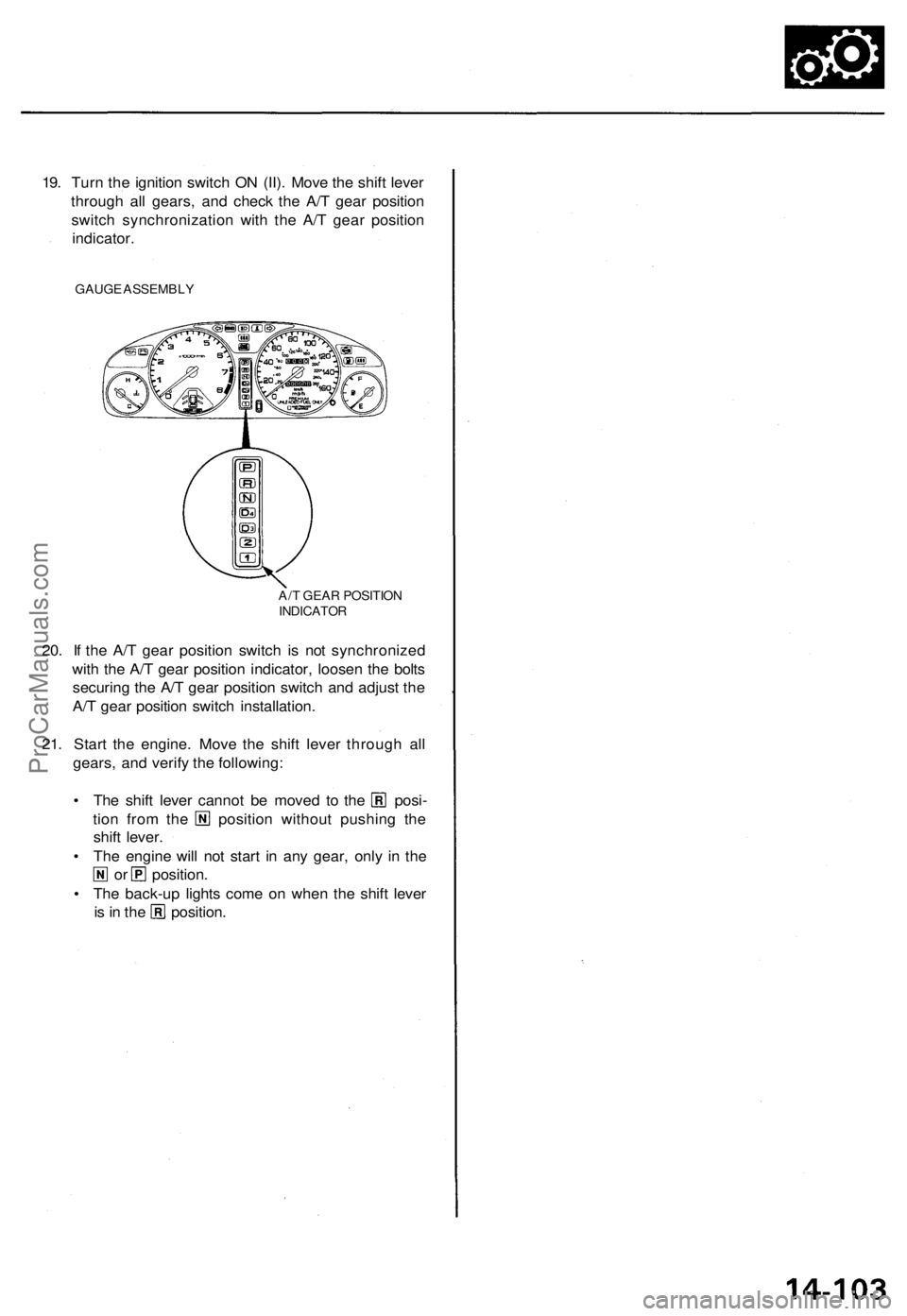
19. Turn the ignition switch ON (II). Move the shift lever
through all gears, and check the A/T gear position
switch synchronization with the A/T gear position
indicator.
GAUGE ASSEMBLY
20. If the A/T gear position switch is not synchronized
with the A/T gear position indicator, loosen the bolts
securing the A/T gear position switch and adjust the
A/T gear position switch installation.
21. Start the engine. Move the shift lever through all
gears, and verify the following:
• The shift lever cannot be moved to the posi-
tion from the position without pushing the
shift lever.
• The engine will not start in any gear, only in the
or position.
• The back-up lights come on when the shift lever
is in the position.
A/T GEAR POSITION
INDICATORProCarManuals.com
Page 320 of 1771
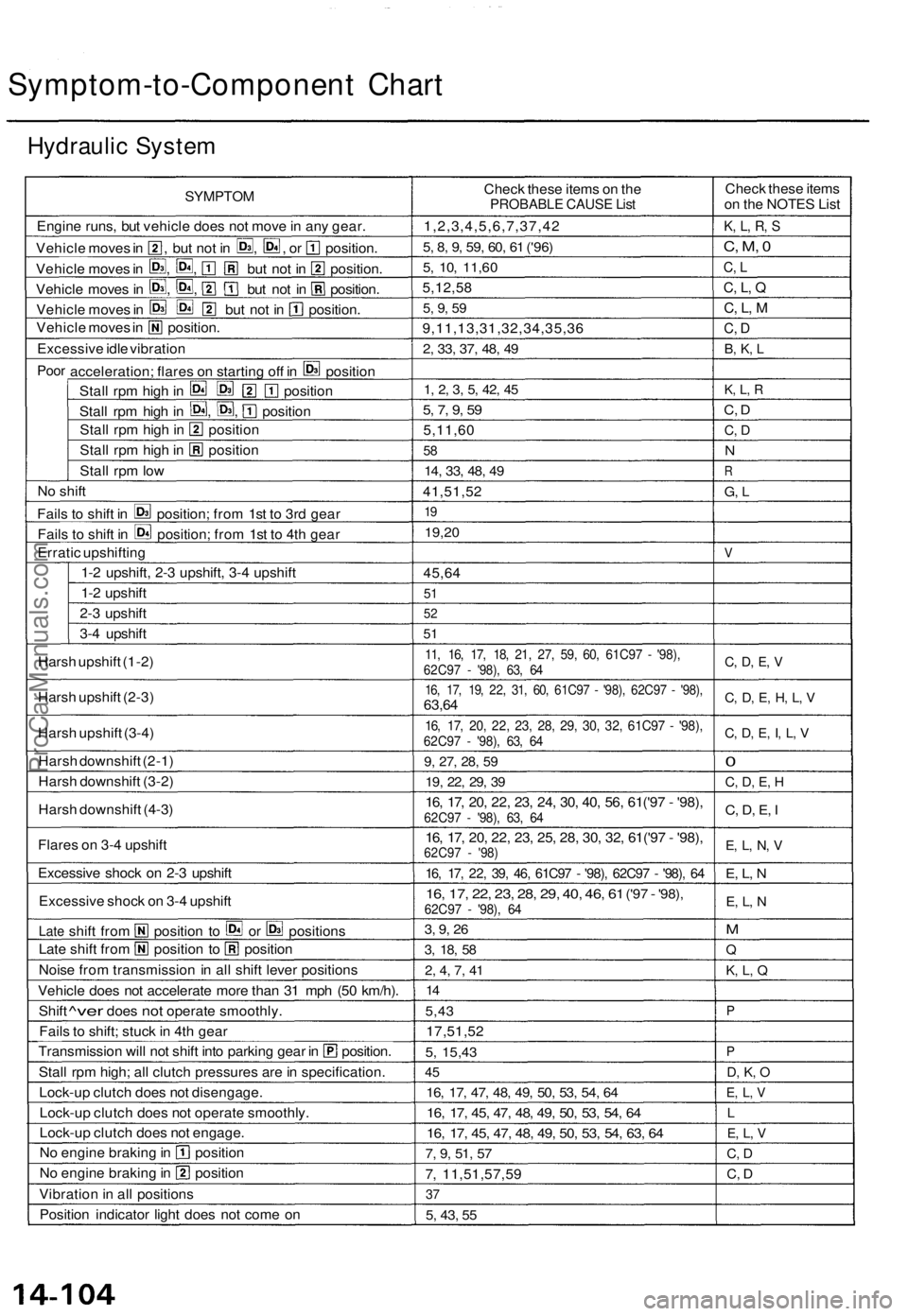
Symptom-to-Component Chart
Hydraulic System
SYMPTOM
Engine runs, but vehicle does not move in any gear.
Vehicle moves in , but not in , , or position.
Vehicle moves in , , but not in position.
Vehicle moves in , , but not in position.
Vehicle moves in but not in position.
Vehicle moves in position.
Excessive idle vibration
Poor
acceleration; flares on starting off in position
Stall rpm high in position
Stall rpm high in , , position
Stall rpm high in position
Stall rpm high in position
Stall rpm low
No shift
Fails to shift in position; from 1st to 3rd gear
Fails to shift in position; from 1st to 4th gear
Erratic upshifting
1-2 upshift, 2-3 upshift, 3-4 upshift
1-2 upshift
2-3 upshift
3-4 upshift
Harsh upshift (1-2)
Harsh upshift (2-3)
Harsh upshift (3-4)
Harsh downshift (2-1)
Harsh downshift (3-2)
Harsh downshift (4-3)
Flares on 3-4 upshift
Excessive shock on 2-3 upshift
Excessive shock on 3-4 upshift
Late
shift from position to or positions
Late shift from position to position
Noise from transmission in all shift lever positions
Vehicle does not accelerate more than 31 mph (50 km/h).
Shift
^ver
does
not
operate smoothly.
Fails to shift; stuck in 4th gear
Transmission will not shift into parking gear in position.
Stall
rpm high; all clutch pressures are in specification.
Lock-up clutch does not disengage.
Lock-up clutch does not operate smoothly.
Lock-up clutch does not engage.
No engine braking in position
No engine braking in position
Vibration in all positions
Position indicator light does not come on
Check these items on the
PROBABLE CAUSE List
1,2,3,4,5,6,7,37,42
5, 8, 9, 59, 60, 61
('96)
5, 10,
11,60
5,12,58
5, 9, 59
9,11,13,31,32,34,35,36
2, 33, 37, 48, 49
1, 2, 3, 5, 42, 45
5, 7, 9, 59
5,11,60
58
14, 33, 48, 49
41,51,52
19
19,20
45,64
51
52
51
11, 16, 17, 18, 21, 27, 59, 60, 61C97 - '98),
62C97 - '98), 63, 64
16, 17, 19, 22, 31, 60, 61C97 - '98), 62C97 - '98),
63,64
16, 17, 20, 22, 23, 28, 29, 30, 32, 61C97 - '98),
62C97 - '98), 63, 64
9, 27, 28, 59
19, 22, 29, 39
16, 17, 20, 22, 23, 24, 30, 40, 56, 61('97 - '98),
62C97 - '98), 63, 64
16, 17, 20, 22, 23, 25, 28, 30, 32, 61('97 - '98),
62C97 - '98)
16, 17, 22, 39, 46, 61C97 - '98), 62C97 - '98), 64
16, 17, 22, 23, 28, 29, 40, 46, 61
('97
-
'98),
62C97 - '98), 64
3, 9, 26
3, 18, 58
2, 4, 7, 41
14
5,43
17,51,52
5,
15,43
45
16, 17, 47, 48, 49, 50, 53, 54, 64
16, 17, 45, 47, 48, 49, 50, 53, 54, 64
16, 17, 45, 47, 48, 49, 50, 53, 54, 63, 64
7, 9, 51, 57
7, 11,51,57,59
37
5, 43, 55
Check these items
on the NOTES List
K, L, R, S
C, M, 0
C, L
C, L, Q
C, L, M
C, D
B, K, L
K, L, R
C, D
C, D
N
R
G, L
V
C, D, E, V
C, D, E, H, L, V
C, D, E, I, L, V
0
C, D, E, H
C, D, E, I
E, L, N, V
E, L, N
E, L, N
M
Q
K, L, Q
P
P
D, K, O
E, L, V
L
E, L, V
C, D
C, DProCarManuals.com
Page 321 of 1771
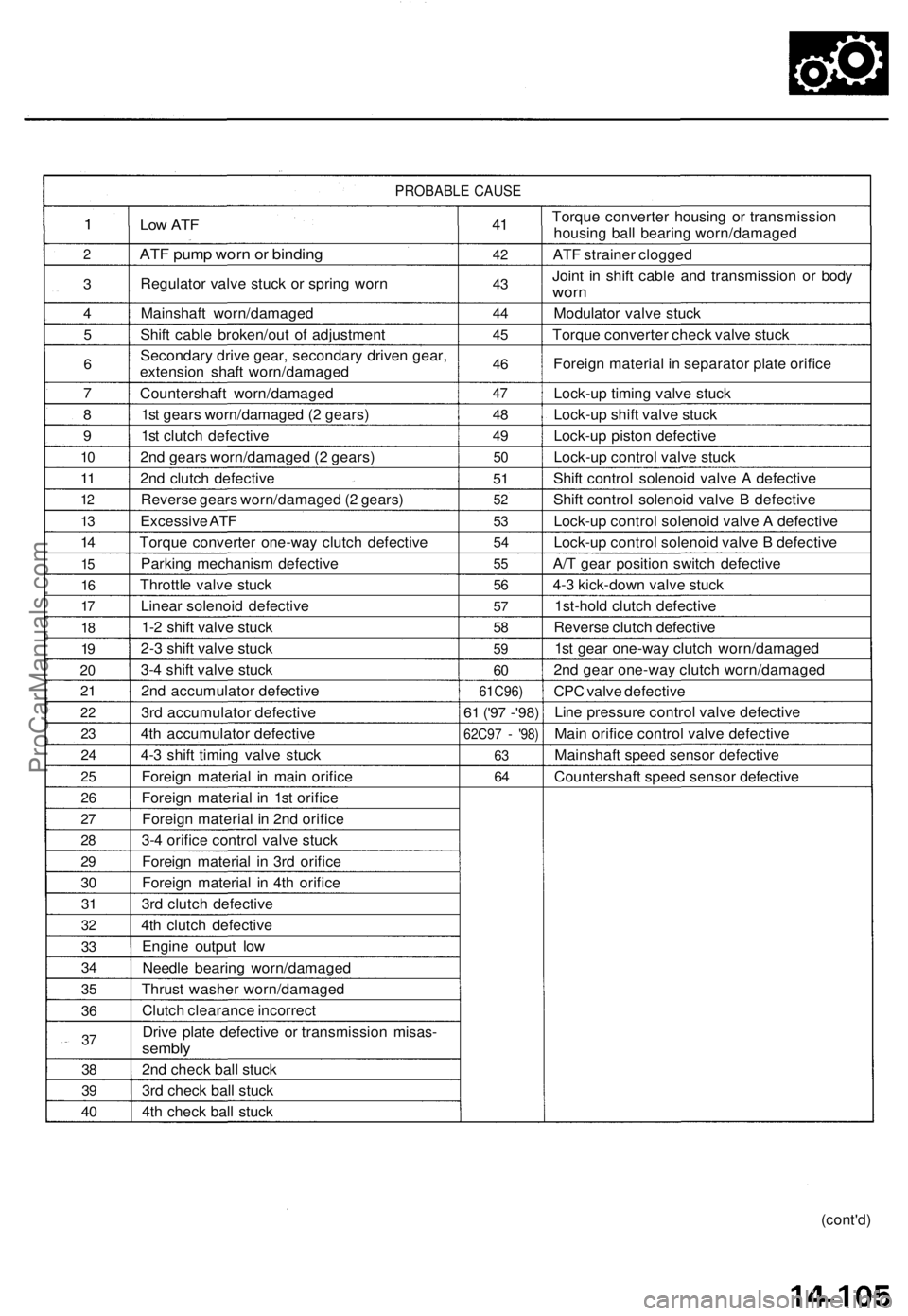
PROBABLE CAUSE
1
2
3
4
5
6
7
8
9
10
11
12
13
14
15
16
17
18
19
20
21
22
23
24
25
26
27
28
29
30
31
32
33
34
35
36
37
38
39
40
Low ATF
ATF pump worn or binding
Regulator valve stuck or spring worn
Mainshaft worn/damaged
Shift cable broken/out of adjustment
Secondary drive gear, secondary driven gear,
extension shaft worn/damaged
Countershaft worn/damaged
1st gears worn/damaged (2 gears)
1st clutch defective
2nd gears worn/damaged (2 gears)
2nd clutch defective
Reverse gears worn/damaged (2 gears)
Excessive ATF
Torque converter one-way clutch defective
Parking mechanism defective
Throttle valve stuck
Linear solenoid defective
1-2 shift valve stuck
2-3 shift valve stuck
3-4 shift valve stuck
2nd accumulator defective
3rd accumulator defective
4th accumulator defective
4-3 shift timing valve stuck
Foreign material in main orifice
Foreign material in 1st orifice
Foreign material in 2nd orifice
3-4 orifice control valve stuck
Foreign material in 3rd orifice
Foreign material in 4th orifice
3rd clutch defective
4th clutch defective
Engine output low
Needle bearing worn/damaged
Thrust washer worn/damaged
Clutch clearance incorrect
Drive plate defective or transmission misas-
sembly
2nd check ball stuck
3rd check ball stuck
4th check ball stuck
41
42
43
44
45
46
47
48
49
50
51
52
53
54
55
56
57
58
59
60
61C96)
61
('97 -'98)
62C97 - '98)
63
64
Torque converter housing or transmission
housing ball bearing worn/damaged
ATF strainer clogged
Joint in shift cable and transmission or body
worn
Modulator valve stuck
Torque converter check valve stuck
Foreign material in separator plate orifice
Lock-up timing valve stuck
Lock-up shift valve stuck
Lock-up piston defective
Lock-up control valve stuck
Shift control solenoid valve A defective
Shift control solenoid valve B defective
Lock-up control solenoid valve A defective
Lock-up control solenoid valve B defective
A/T gear position switch defective
4-3 kick-down valve stuck
1st-hold clutch defective
Reverse clutch defective
1st gear one-way clutch worn/damaged
2nd gear one-way clutch worn/damaged
CPC valve defective
Line pressure control valve defective
Main orifice control valve defective
Mainshaft speed sensor defective
Countershaft speed sensor defective
(cont'd)ProCarManuals.com
Page 323 of 1771
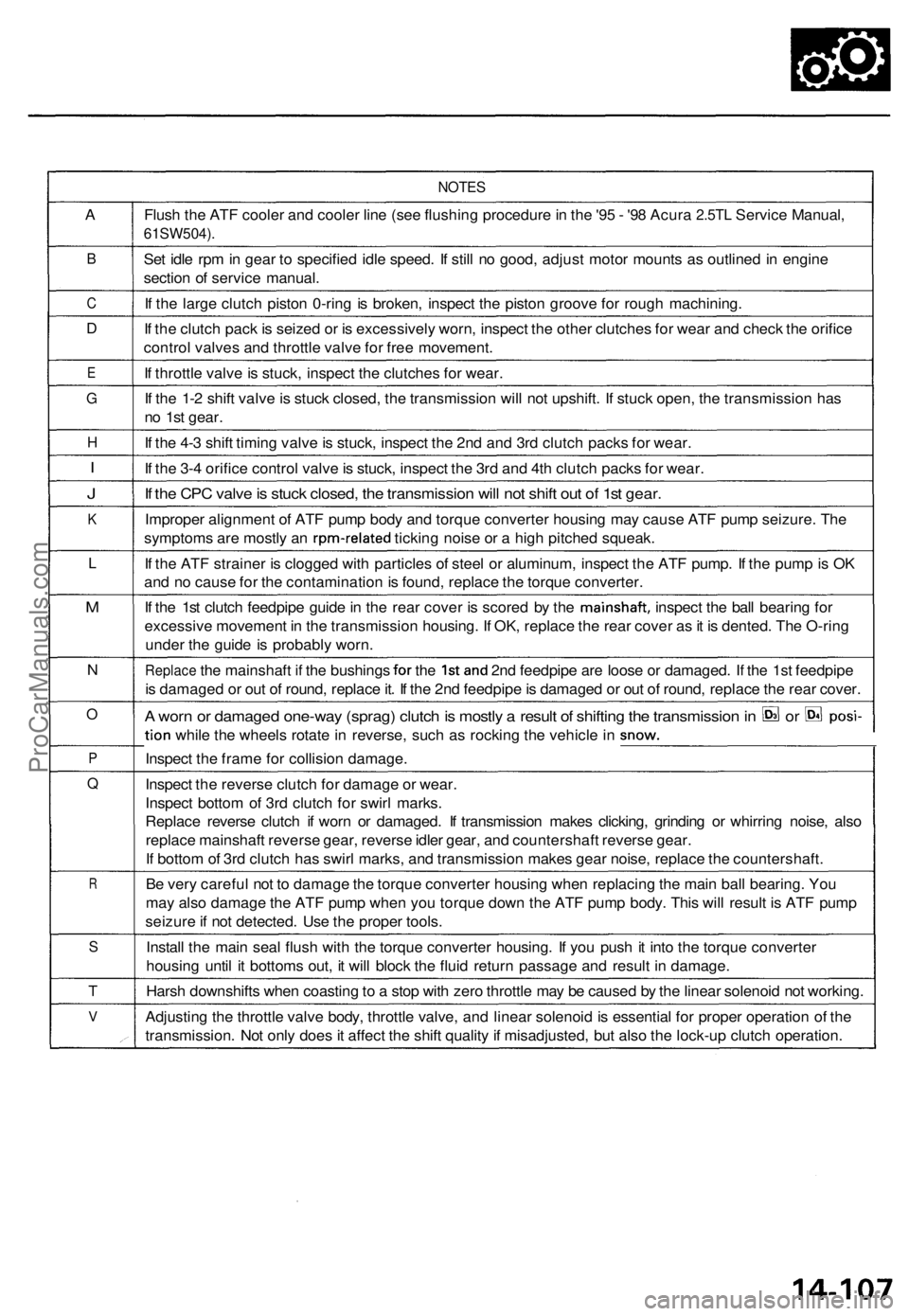
Set idl e rp m in gea r t o specifie d idl e speed . I f stil l n o good , adjus t moto r mount s a s outline d in engine
sectio n o f servic e manual .
I f th e larg e clutc h pisto n 0-rin g i s broken , inspec t th e pisto n groov e fo r roug h machining .
I f th e clutc h pac k is seize d o r i s excessivel y worn , inspec t th e othe r clutche s fo r wea r an d chec k th e orific e
contro l valve s an d throttl e valv e fo r fre e movement .
I f throttl e valv e is stuck , inspec t th e clutche s fo r wear .
I f th e 1- 2 shif t valv e is stuc k closed , th e transmissio n wil l no t upshift . I f stuc k open , th e transmissio n ha s
n o 1s t gear .
I f th e 4- 3 shif t timin g valv e is stuck , inspec t th e 2n d an d 3r d clutc h pack s fo r wear .
I f th e 3- 4 orific e contro l valv e is stuck , inspec t th e 3r d an d 4t h clutc h pack s fo r wear .
If th e CP C valv e is stuc k closed , th e transmissio n wil l no t shif t ou t o f 1s t gear .
Imprope r alignmen t o f AT F pum p bod y an d torqu e converte r housin g ma y caus e AT F pum p seizure . Th e
symptom s ar e mostl y a n rpm-relate d ticking nois e o r a hig h pitche d squeak .
I f th e AT F straine r i s clogge d wit h particle s o f stee l o r aluminum , inspec t th e AT F pump . I f th e pum p is O K
an d n o caus e fo r th e contaminatio n is found , replac e th e torqu e converter .
If th e 1s t clutc h feedpip e guid e in th e rea r cove r i s score d b y th e mainshaft , inspect th e bal l bearin g fo r
excessiv e movemen t i n th e transmissio n housing . I f OK , replac e th e rea r cove r a s it i s dented . Th e O-rin g
unde r th e guid e is probabl y worn .
Replac e the mainshaf t if th e bushing s for the Islan d 2nd feedpip e are loos e or damaged . If th e 1s t feedpip e
i s damage d o r ou t o f round , replac e it . I f th e 2n d feedpip e is damage d o r ou t o f round , replac e th e rea r cover .
A wor n o r damage d one-wa y (sprag ) clutc h is mostl y a resul t o f shiftin g th e transmissio n in S o r S posi -
tion whil e the wheel s rotat e in reverse , suc h as rockin g the vehicl e in snow.__________________ _
Inspect th e fram e fo r collisio n damage .
Inspec t th e revers e clutc h fo r damag e o r wear .
Inspec t botto m o f 3r d clutc h fo r swir l marks .
Replac e revers e clutc h i f wor n o r damaged . I f transmissio n make s clicking , grindin g o r whirrin g noise , als o
replac e mainshaf t revers e gear , revers e idle r gear , an d countershaf t revers e gear .
I f botto m of 3r d clutc h ha s swir l marks , an d transmissio n make s gea r noise , replac e th e countershaft .
B e ver y carefu l no t t o damag e th e torqu e converte r housin g whe n replacin g th e mai n bal l bearing . Yo u
ma y als o damag e th e AT F pum p whe n yo u torqu e dow n th e AT F pum p body . Thi s wil l resul t i s AT F pum p
seizur e if no t detected . Us e th e prope r tools .
Instal l th e mai n sea l flus h wit h th e torqu e converte r housing . I f yo u pus h it int o th e torqu e converte r
housin g unti l i t bottom s out , i t wil l bloc k th e flui d retur n passag e an d resul t i n damage .
Hars h downshift s whe n coastin g to a sto p wit h zer o throttl e ma y b e cause d b y th e linea r solenoi d no t working .
Adjustin g th e throttl e valv e body , throttl e valve , an d linea r solenoi d is essentia l fo r prope r operatio n o f th e
transmission . No t onl y doe s it affec t th e shif t qualit y i f misadjusted , bu t als o th e lock-u p clutc h operation .
A
B
C
D
E
G
H
I
J
K
L
M
N
O
P
Q
R
S
T
V
Flush th e AT F coole r an d coole r lin e (se e flushin g procedur e in th e '95 - '98 Acur a 2.5TL Servic e Manual ,
61SW504) .
NOTES
ProCarManuals.com